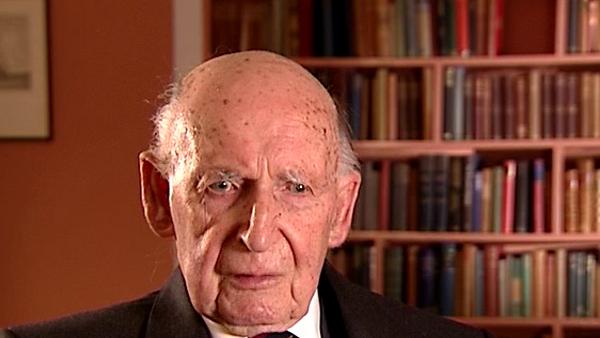NEXT STORY

Studying radar echoes from the Moon
RELATED STORIES

NEXT STORY

Studying radar echoes from the Moon
RELATED STORIES



We had various other pieces of work going on in... in meteors. Greenhow, Dennis Greenhow, was using... we... we laid down at a large tarmac slab in which is now the green at Jodrell and on that, Greenhow used that as a reflecting device to produce, so that he could measure the actual heights of the meteors and he published an interesting series of papers on the... on the movement of the meteor stream which he had recorded, and published papers on... on the distribution of the velocities of the winds in the 80... 80-100 kilometre region of the atmosphere. An entirely different matter concerned the problem of the... of the radio... radio emission from Cygnus.
Now, Hey, in his first survey of the heavens immediately after the war, had not only plotted the distribution of radio emission from the galaxy, but in this distribution, he identified what appeared to be a localised source in Cygnus. He discovered that this particular source was scintillating, was... was fluctuating and he concluded from this, that the... that he was observing what he called a point source or very localised source of... of radio emission, and its position then was quite unknown. It was never... it was not known whether it was in the galaxy or... or extra-galactic.
Well, as a matter of fact, much later it was discovered to be one of the important, very powerful extra-galactic radio sources at a considerable distance, but we became interested in fluctuations because we did not altogether believe that Hey's conclusion was correct, and so we set out to study the scintillations from the source of the signals. And this is quite a simple matter to do. We had a system... two systems, one of which we stationed at Jodrell and we would observe on a paper chart, the signal from Cygnus and just observe the fluctuations and another exactly similar system, we would move about first of all at Jodrell, and then we brought it here and then we... we collaborated with Cambridge, and they... and they observed simultaneously there, simultaneously to Jodrell.
Well, the answer was perfectly clear. I remember showing them to Blackett who was working with the CG Little on this and we spread out the charts on... on the floor of this room and... and even from Jodrell... the records from Jodrell compared with the Jodrells from here, only a few miles away it was quite distinct that the fluctuations were of a... of a different frequency, and therefore Hey had reached the correct... as it turned out, he had reached the correct conclusion, but from the wrong reasoning. In fact, the scintillations were not from the source itself, but were being imposed by the transmission through the ionosphere.
Now, for an entirely different reason, Martin Ryle, who was now making great progress at Cambridge, didn't want... he didn't want... did not want to believe this. He had just published a paper on... on radio sources and he... he, I think, wanted them all to be in... in the galaxy and if you look at the publications in Nature about this, you will find there are two – they're not a joint publication by Cambridge and Jodrell – but... but two simultaneous publications, one by Jodrell, giving the definite result that they were all from the ionosphere, and one by Ryle... I'm not sure, I think by Graham Smith, I must ask him about that, also saying they did not disagree but they still believed that some of the scintillations might be directly in the source itself. Anyhow, that was an... an interesting and... and rather simple piece of work which was conclusive and Little and then another young student, Maxwell, who I still see. He now lives... he went to America, but he was from New Zealand and he... he and Little studied these scintillations and did quite a lot of work on the atmosphere and so on from that. So that's the kind of researches that were going on that we were involved in when... when we began the construction of the steerable telescope in... in 1952.
Bernard Lovell (1913-2012), British radio astronomer and founder of the Jodrell Bank Observatory, received an OBE in 1946 for his work on radar, and was knighted in 1961 for his contribution to the development of radio astronomy. He obtained a PhD in 1936 at the University of Bristol. His steerable radio telescope, which tracked Sputnik across the sky, is now named the Lovell telescope.
Title: Work on meteors at Jodrell Bank: Looking at fluctuations
Listeners: Megan Argo Alastair Gunn
Megan Argo is an astronomer at the University of Manchester's Jodrell Bank Observatory researching supernovae and star formation in nearby starburst galaxies. As well as research, she is involved with events in the Observatory's Visitor Centre explaining both astronomy and the history of the Observatory to the public.
Alastair Gunn is an astrophysicist at Jodrell Bank Observatory, University of Manchester. He is responsible for the coordination and execution of international radio astronomical observations at the institute and his professional research concerns the extended atmospheres of highly active binary stars. Alastair has a deep interest and knowledge of the history of radio astronomy in general and of Jodrell Bank in particular. He has written extensively about Jodrell Bank's history.
Tags: Jodrell Bank, Cygnus, Cambridge University, Nature, New Zealand, USA, Dennis Greenhow, C G Little, Patrick Blackett, Martin Ryle
Duration: 5 minutes, 40 seconds
Date story recorded: January 2007
Date story went live: 05 September 2008